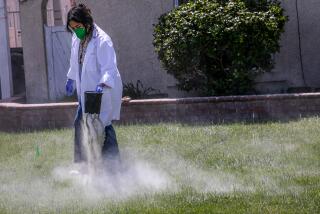ENVIRONMENT : Guyana Cyanide Spill a Peril of Latest Alchemy : Process using poison is a popular way of squeezing gold out of marginal mines. Ecologists decry the trend.
- Share via
MEXICO CITY — A recent cyanide spill from a South American gold mine, which poured 113 million cubic feet of poisonous runoff into one of Guyana’s largest rivers, has provided a real-life example of the environmental havoc that can be wrought by one of the latest techniques for squeezing gold from ore.
Entrepreneurs have turned to “cyanide heap-leaching”--the technique used in the Guyana mine that last month caused the worst ecological disaster in the history of the former British colony--in the American West, northern Mexico and other parts of the world to reopen mines and turn marginal deposits into viable sources of gold.
One such project, proposed for an area near Yellowstone National Park, faces strong opposition from environmentalists.
“Most post-1980 gold mines use cyanide leaching,” noted Dick Kamp, an environmental activist based in Bisbee, Ariz., who monitors reopened mines in his own state and the new La Choya mine just across the border, now Mexico’s biggest gold producer. “There’s a big explosion. Cyanide heap-leach is the future.”
Environmentalists find this worrisome. Cyanide spills have already occurred at a gold mine in Washington state. Cleanup of the Summitville mine in the San Juan Mountains of southern Colorado--an early venture of the same investors behind the Omai mine in Guyana--is on the Environmental Protection Agency’s national priority list for Superfund projects.
“It just seems like a major environmental impact for a handful of people to walk out with a whole lot of money,” said Robert Stebbens, an ethno-biologist who has had limited success in his fight against cyanide heap-leach mining in the Mojave Desert.
As its name implies, heap-leaching involves piling ore into a heap over an impermeable liner. A caustic chemical is poured or sprayed over the pile of ore. As the chemical leaches through the ore, down to the liner, it brings along the desired mineral, which is then separated from the chemical. With this technique, small amounts of minerals can be economically recovered from huge amounts of ore.
The technique was first used in Spanish copper mines in the mid-18th Century. It was not applied to gold until the early 1970s, experts say.
By 1980, one-third of American gold ore--4 million tons--was processed with this technique. Seven years later, 65 million tons of gold ore were processed with the new method in the United States alone. International figures were unavailable, but observers believe the worldwide trend is comparable to the U.S. figures.
Mining industry representatives argue that the technique is not dangerous. They say that relatively weak concentrations of cyanide are used. They also note that cyanide dissipates quickly, making it far less dangerous than an alternative such as mercury, which is used extensively in Brazilian gold mining.
The industry has also developed new methods that minimize the potential for spills and other types of accidents. “If it is closely monitored and companies pay large bonds [to secure their performance], the sites probably can be detoxified,” Kamp acknowledged.
But mines have not been closely monitored and only minimal bonds have been demanded, according to research by the Mineral Policy Center, a Washington-based environmental group.
Cyanide heap-leaching is also being used in Arizona wildcat operations that reopen mines on a shoestring budget, Kamp said. Those miners do not have the financial base to pay the costs in the event of an environmental disaster.
Both the domestic and international trends have environmentalists worried. “If people have a cheap way to get gold out of the ground, they will,” Kamp said. “There’s a boom going on. There is a lot of possibility for more Guyanas to happen because there isn’t the capacity to oversee them.”
(BEGIN TEXT OF INFOBOX / INFOGRAPHIC)
Mining With Cyanide
Cyanide is used to strip gold from ore at plants around the world. Mining industry representatives defend the technique, arguing that cyanide dissipates quickly and is less dangerous than alternatives. Here is how the cyanide system works:
1. Ore containing particles of gold is piled across the processing pit.
2. Cyanide is sprayed over the piles of ore.
3. As chemical leaches through the ore, it carries along gold and collects in impermeable liner at base of pit.
4. Solution flows to collecting pond.
5. Pumps send the solution to plant for separation, processing.
Sources: Audubon Society, Mineral Policy Center
More to Read
Sign up for Essential California
The most important California stories and recommendations in your inbox every morning.
You may occasionally receive promotional content from the Los Angeles Times.













